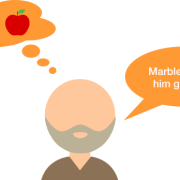The Strangest of the Things
I believe that by now you all have watched – or started to – the 3rd season of Stranger Things. I know the rules, this article is spoiler free, so you can go ahead and keep reading it without any concern. Many things have been said about the presence of Universal Grammar (UG) in both first and second language acquisition process. Watching Netflix’s series Stranger Things may help you notice that UG is not one hundred percent responsible for the success of a language acquisition.
The studies on language acquisition under the perspective of Universal Grammar suggest that due to evolutionary processes, we all developed a special device responsible for the production and understanding of languages. This UG resembles a template where we would insert words that we have been exposed to thus resulting in sentences that are produced in conversations. Considering the acquisition of a given mother tongue (L1), through a few instances of exposure, a child is capable of constructing word connections which will then provide the meaning to sustain a conversation (Chomsky, 1986, Pinker, 1994). Therefore, a child would have to be exposed to (1) a few times so that she could then understand the positioning of each word and generalize its newly-designed rule, i.e. that a determiner goes in front of the sentence together with a noun whose predicate is formed by ‘to be’ conjugated for third person combined with the adjective ‘long’.
(1) The week is long.
(2) The week is short.
(3) The day is long.
(4) The day is short.
A child needs to generalize this novel construction to produce variants of that sentence such as (2)-(4), insert each word in its respective slot – as if it were Cartesian – to construct a sentence. However, there are some gaps in this assumption related to UG that can be addressed by watching the latest season of Stranger Things. There is an episode in which a sub group of the teenage heroes intercepts a Russian message that follows ‘The week is long. The silver cat feeds when blue meets yellow in the west. A trip to China sounds nice if you tread lightly.’. This code is translated from Russian by the teens (here it will be considered their second language – L2) and according to generative grammar studies, this would be enough for them to be able to communicate in Russian for they already know the words and can now generalize the construction to other sentences. However, this would be impossible since the teen group had no social interaction with Russian speakers, therefore they could not understand the speaker’s intention. Shared intention is what gives meaning to utterances (Tomasello, 2003), i.e. a child observes how normally an adult behaves, understands the proposition and then puts such construction into practice.
It is important to highlight that the propositional aspect of the construction is what makes children acquire the language and not the language itself (Dabrowska, 2009). Regarding a second language acquisition process, this association of proposition also happens in tandem with the native language. Our native language is one of the codes we have for mental representations – images are more common – and we join whatever representation we have in our mind to the linguistic representation we already possess. This is the reason the teens in the show cannot be considered first class users of the Russian language. When they finally associated the word combination to English (their native language), they realized that ‘the week is long’ and all other sentences made no sense, as if they were uttered randomly with no purpose whatsoever. Pragmatically, at first, the sentences uttered by the Russians seemed illocutionary, but Austin’s lectures show that every speech is locutionary, i.e. every speech has a meaning, a purpose.
The meaning of the code shown on the episode will certainly be not revealed in this article (remember this is a spoiler free article). However, if UG was the main factor for language acquisition, if a minimal exposure was enough to grammaticalize speeches and generate full meaning, then the group of teenagers would crack the code as soon as they were able to translate it to English. In fact, the WWII would have been a lot shorter if intercepted encoded messages were cracked by translating them, but they are not. We don’t have a special device dedicated to languages, but we do use many parts of our brain to learn languages and we also create mental representations to associate with a specific language use and we transfer this combo when we learn other languages.
If you really want to know more about this Russian encoded messages, go to Netflix right now and watch the amazing season 3 of Stranger Things, but if your interest is on language acquisition process, then share this article and browse all other articles on this issue here. (…) Or maybe you can do both.












Perfectly explained, bro. Well done!